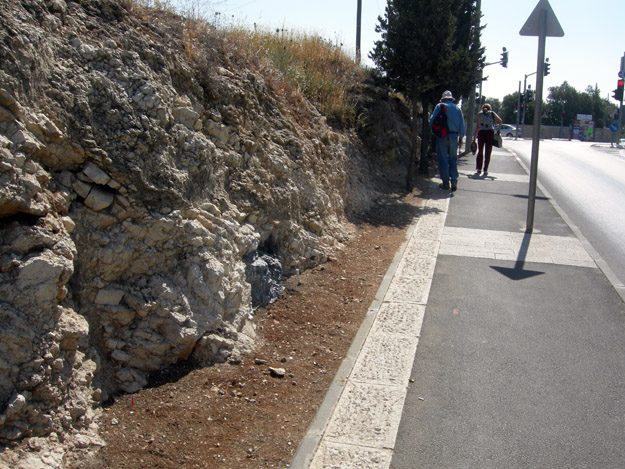My last geological fieldwork (if we can call it that) in Israel on this trip was to examine the Upper Cretaceous limestones and dolomites exposed in Jerusalem. I far prefer my rocks be found in pristine wilderness areas with only bird songs in the background, but the right rocks, of course, can be anywhere. Sometimes, then, we have to work with traffic zooming by, sirens wailing, blasts of car exhaust, and schoolchildren offering to hammer the rocks for us.
The coolest location was in the moshav of Beit Zeit, just five minutes from downtown Jerusalem. (A moshav is a type of cooperative agricultural community, although in this case heavily urbanized.) A beautiful trackway of ornithomimosaur dinosaur footprints is exposed on a bedding plane of Lower Cenomanian limestone.
The site is of great importance because thus far these are the only dinosaur tracks known in the entire Middle East. The local community purchased the land and erected a protective roof over the trackways. They had a mural painted showing what the area may have looked like in the Cretaceous, installed a custom-made life-size dinosaur model on the bedding plane, and made the area into an educational park. You can see for yourself what happened later. The surrounding fence was too low, so it became a drug hangout, vandals spray-painted the mural and then broke the dinosaur into bits. (The crater where the dinosaur stood is just visible in the photo.) This natural wonder was simply too accessible to the public. There are plans to protect the site more thoroughly, and then reconstruct the displays.
I was able to collect a small piece of the limestone bedding plane for analysis back in Wooster. My hypothesis is that the limestone is a marine hardground which cemented very soon after the dinosaurs waded across it, thereby preserving the prints. A thin-section of the rock may show if it had these early cements.
The rest of our urban geological work was on the streets of Jerusalem. Rocky outcrops are common because the city is built on several steep hills which have been quarried for thousands of years. We were able to correct the geological map in some places because of new exposures, and I gathered several ideas for future projects.





Why “sweet”?
Oh good question. The rock is very fine-grained and cream-colored. When you break it with a hammer it is smooth on the inside like excellent fudge or peanut brittle. Stone masons long ago thus began to use the word “hilu” for it, which means “candy” in Arabic and later evolved into simply “sweet”.